Berkshire Street Traffic Calming
Cambridge, Massachusetts
Source: Pedestrian and Bicycle Information Center (PBIC)
Problem
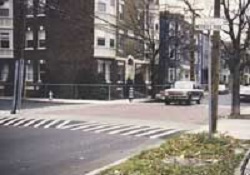
Raised intersection at Berkshire and Marcella Streets.
Motorists traveling at high speeds and refusing to stop at Stop signs on residential and mixed-use neighborhood streets, especially those populated with large volumes of pedestrians (including children), had consequently led to many pedestrians being hit by motor vehicles.
Background
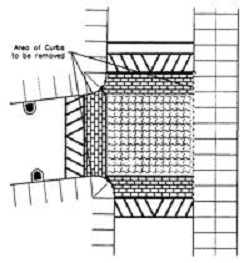
Raised intersection used at York and Hamilton and Berkshire and Marcella.
Berkshire and York Streets are located in the Wellington/Harrington neighborhood of Cambridge, a residential area with a mix of businesses and retail shops. Berkshire is a neighborhood street with a 25 mi/h posted speed limit and 2,000-2,500 ADT count. A school, a playing field, a youth center, and a library are adjacent to Berkshire Street. The mix of uses generates a large volume of pedestrian traffic, especially from children. Berkshire Street is also a popular cut-through for motorists, particularly as an alternative to Cardinal Medeiros Avenue, a much larger arterial which carries high traffic volumes during peak hours.
Neighborhood residents had complained over a long period of time about speeding vehicles. Police checks confirmed the persistent speeding problem along Berkshire and also found a large number of drivers running the stop sign at the intersection of York and Plymouth. Several incidents between children and drivers motivated parents and other residents to tackle the traffic problems in their neighborhood, making the streets safer for children to walk.
Solution
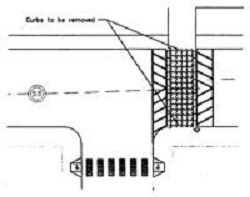
A raised crosswalk used on Berkshire Street at Hardwick Street.
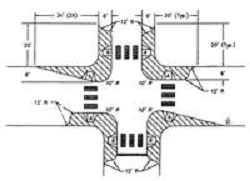
A chicane was added on Berkshire Street between York and Cambridge.
The City of Cambridge chose the Berkshire/York Street area to demonstrate the benefits of traffic calming for addressing neighborhood transportation problems. Working jointly with the City Traffic Department and the Public Works Department, the Community Development Department publicized and facilitated an open planning process, involving many neighborhood residents, school personnel, and emergency services personnel. The collaboration produced several traffic calming design alternatives, with the community and city agencies eventually using the design presented here. The Public Works Department implemented the improvements using city funds.
The Berkshire and York Street improvements were part of a comprehensive traffic calming plan. Under this plan, a particular area is blanketed by a variety of treatments, which work together to change the nature of roadways, slow down vehicles, and improve pedestrian safety.
The traffic calming measures used in this project include the following:
- Curb extensions at three intersections: 1) Berkshire and York Streets, 2) Berkshire and Cambridge Streets, and 3) Webster Avenue, Hamlin Street, and Plymouth Street.
- Hamlin Street was made one-way to alleviate the problem of drivers entering Plymouth Street the wrong way at Webster Avenue to get to Hamlin Street.
- A raised crosswalk was added across Berkshire Street at Hardwick Street.
- Raised intersections were constructed at York and Hamilton and Berkshire and Marcella.
- A chicane was added on Berkshire Street, which reduces the street width by 7 ft on each side and introduces a shift in the roadway alignment.
- The fence openings for Donnelly Field were relocated to line up with the enhanced pedestrian crossings, encouraging pedestrians, especially children, to cross where it is safest to do so.
- In addition to the newly constructed treatments, all street-level crosswalks were repainted with zebra markings to emphasize the presence of a pedestrian crossing for both drivers and pedestrians.
- The raised crosswalk and intersections were constructed with concrete pavers that replicate the look and feel of brick but are more durable and have a slip resistant finish. The approaching slopes for the vertical changes were constructed at 8 percent. The approaching slopes are clearly marked, using highly visible, reflective, and slip resistant inlay tape as pavement markings.
Results
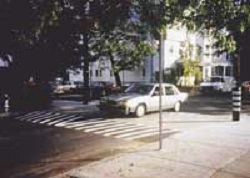
Raised crosswalk at Berkshire and Hardwick.
Overall, the Berkshire/York street neighborhood is now a much safer place for young pedestrians in the neighborhood. While all of the measures combined to change the driving atmosphere of the street, the vertical traffic calming measures have the most direct effect on travel speeds.
Before the improvement, the 85th percentile speed on Berkshire Street was 30 mi/h, and only 41 percent of vehicles surveyed were traveling at or below the 25 mi/h speed limit. After the improvements, the 85th percentile speed was reduced to 21 mi/h at the vertical traffic calming devices and 24 mi/h in between, and 95 percent of vehicles were going at or below the speed limit.
The chicane provides an area for landscaping, and for motorists, it disrupts the visual continuity of the street without a measurable impact on traffic. Curb extensions reduce the width of the pedestrian crossing distance, limit pedestrian exposure time, improve visibility, and slow the turning vehicles. While there have not been any major maintenance problems, the City continues to monitor the improvements closely, particularly through the winter.
A post-improvement survey of neighborhood residents found that 44 percent of respondents liked the improvements while only 28 percent disliked them. Forty-seven percent reported a perceived increase in pedestrian safety and 39 percent reported feeling an improvement in the safety for children playing. However, 61 percent reported that it was harder to find on-street parking, despite the net loss of only one on-street parking space.
The City of Cambridge considers the project a major success, both for the implementation of effective traffic calming measures and for the ability of the public participation process to mobilize the neighborhood and generate support for the improvements. The Berkshire/York street project has led to the development of several other neighborhood projects throughout the city.
Contact
Juan P. Avendano
Traffic Calming Project Manager
Community Development Department
City of Cambridge
238 Broadway
Cambridge, MA 02188
Phone: (617) 349-4655
Email: traffic calming@ci.cambridge.ma.us
www.ci.cambridge.ma.us/~CDD/envirotrans




